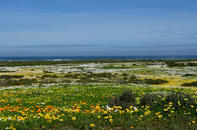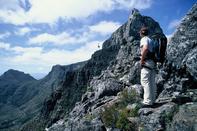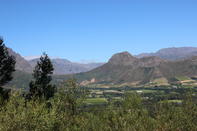Soil and Flora
In many ways the south-western tip of Africa is a world apart, isolated in sense and form from the rest of the sub-continent of Southern Africa; in appearance it is like an old and craggy face which every season receives the attention of the nature's finest make-up artist to compensate for its old age, its poor diet and its cracked and flaking skin.

The climatic extremes and the contorted landscape create the complex natural environment which harbours by far the smallest and yet richest of the world's six floral kingdoms.
The Cape Floral Kingdom extends roughly from Vanrhynsdorp in the north-west to Humansdorp in the east. This is the area of the Cape Supergroup of rocks that were laid down as marine and deltaic sediments between 500 and 350 million years ago a period that spans most of the Palaeozoic era (Ordovician, Silurian and Devonian periods).
They rest on top of older Cape Granites and Malmesbury Group shales which can be clearly seen in the Peninsula area, forming the gentler slopes below the sandstone cliffs of the mountains. Cruise along Chapman's Peak Drive and you will notice how the shale and sandstone cliffs lie directly on paler, more rounded granite rocks that tumble steeply down to the sea.
Table Mountain Group

The first group of rocks of the Cape system is the Table Mountain Group, composed mainly of coarse quartzitic sandstones alternating with thin bands of shale that were laid down in shallow marine waters of the Agulhas Basin; these rocks are generally referred to as Table Mountain Sandstone (TMS).
After this period inland conditions must have changed, for over the next period the deposits in the basin were not marine sands but were brought down by eight main delta systems flowing from the northern highlands and Gondwanaland Atlantic Mountains to the west.
They deposited mostly shale sediments, with thin sandstone layers in between, on top of the Table Mountain Sandstone to form the Bokkeveld Group of rocks. After this period conditions similar to that of the Table Mountain Sandstone period resumed and the Witteberg sediments were deposited on top of the Bokkeveld, resembling the Table Mountain Sandstone but generally softer and more easily eroded. The Table Mountain Sandstone group of rocks is the oldest of the Cape Supergroup that was laid down in horizontal layers, and therefore generally lies at the bottom of the group.
Through folding, however, and subsequent erosion, the upper layers of soft Bokkeveld shales and Witteberg sandstones have been whittled away from the upward-thrust folds to leave the bases of Table Mountain Sandstone as reminders of mountains that once stood 6 000 metres high.
The Bokkeveld shales now form the long valleys between the parallel ranges of folded mountains, with Witteberg sandstones being confined to ridges along the northern margin of the system. The shales weather to form clayey soils that are far richer than those derived from sandstones and so the valleys are fertile and highly prized for agriculture.
Rich Soils of the Valleys

Valleys such as the Hex River, Franschhoek, Het Land van Waveren around Tulbagh and Wolseley, among others, surrounded by the Groot Drakenstein, Klein Winterhoek, and Witzenberg mountains, and the mighty Hex River Mountains themselves, are famous for their wine and fruit, their graceful Cape Dutch farmhouses and picturesque historical towns.
But farming in these fertile valleys and on the coastal plains has meant that the relatively luxuriant shrublands that grew on the richer soils there have been reduced to less than 10 percent of their former extent. It is only in the harsh mountain areas with their poor soils and climatic extremes that the Cape's flora survives to an acceptable degree but even here it is threatened by an invasion of another kind, namely forestry.
 The Western Cape is a spectacular corner of southern Africa where natural splendour seems to have been concentrated. Ranks of massive grey c...
The Western Cape is a spectacular corner of southern Africa where natural splendour seems to have been concentrated. Ranks of massive grey c... If you’re in search of the perfect blend of adventure, leisure and culture, the Western Cape is your Holy Grail of African travel. From th...
If you’re in search of the perfect blend of adventure, leisure and culture, the Western Cape is your Holy Grail of African travel. From th...